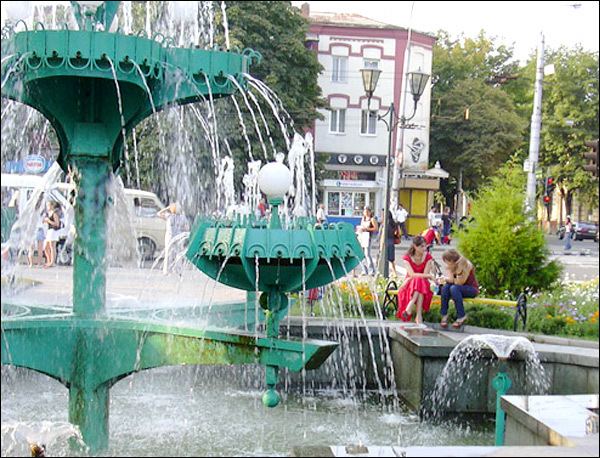Founded May 6, 1784 | Population 311,693 (2010) | |
 | ||
Map of Vladikavkaz
Vladikavkaz (Russian: Владикавка́з; [vlədʲɪkɐˈfkas], lit. ruler of the Caucasus; Ossetian: Дзæуджыхъæу, Dzæudžyqæu; [ˈd͡zəwd͡ʒɨqəw], lit. Dzaug's settlement) is the capital city of the Republic of North Ossetia–Alania, Russia. It is located in the southeast of the republic at the foothills of the Caucasus Mountains, situated on the Terek River. Population: 311,693 (2010 Census); 315,068 (2002 Census); 300,198 (1989 Census). Vladikavkaz is one of the most populous cities in the North Caucasus.
Contents
- Map of Vladikavkaz
- Driving in vladikavkaz north ossetia russia
- History
- Administrative and municipal status
- Transportation
- Population
- Sports
- Notable structures
- Education
- Religion
- Twin towns and sister cities
- Climate
- Notable people
- References

The city is an industrial and transportation center. Manufactures include processed zinc and lead, machinery, chemicals, clothing, and food products.

Driving in vladikavkaz north ossetia russia
History
The city was founded in 1784 as a fortress during the Russian conquest of the Caucasus and was for many years the main Russian military base in the region. The Georgian Military Highway, crossing the mountains, was constructed in 1799 to link the city with Georgia to the south, and in 1875 a railway was built to connect it to Rostov-on-Don and Baku in Azerbaijan. Vladikavkaz has become an important industrial center for the region, with smelting, refining, chemicals and manufacturing industries.
The city is one of the largest in the Russian controlled Caucasus, along with Grozny, and was the capital of the Mountain Autonomous Soviet Socialist Republic, a Soviet Republic established after the annexation of the Mountainous Republic of the North Caucasus. The puppet state existed from 1921-1924, and was part of and in some cases incorporated the modern day territories of Chechnya, North Ossetia, and Kabardino-Balkaria.
From 1931 to 1944 and from 1954 to 1990, its name in both Russian and Ossetic languages was Ordzhonikidze (Орджоники́дзе) (after Sergo Ordzhonikidze, a Georgian Bolshevik), and from 1944 to 1954 it was officially called Dzawdzhikaw (Дзауджика́у) in Russian and (Дзæуджыхъæу) in Ossetic. Vladikavkaz resumed its old Russian name, in 1990, shortly before the dissolution of the Soviet Union; the official Ossetic name was reverted to Дзæуджыхъæу (Dzæudžyqæu).
Vladikavkaz was fought over in both the Russian Civil War and World War II. In February 1919, the anti-Communist Volunteer Army under General Anton Denikin seized the city, before being expelled by the Red Army in March 1920. In November 1942, the forces of Nazi Germany tried unsuccessfully to seize the city but were repelled.
In 1999, 2008, and 2010, Vladikavkaz was a target of bombings.
On November 26, 2008, Vitaly Karayev, the mayor of Vladikavkaz was killed by an unknown gunman. On December 31, 2008, his successor, Kazbek Pagiyev, was also killed by unknown gunmen.
Administrative and municipal status
Vladikavkaz is the capital of the republic. Within the framework of administrative divisions, it is, together with six rural localities, incorporated as Vladikavkaz City Under Republic Jurisdiction—an administrative unit with the status equal to that of the districts. As a municipal division, Vladikavkaz City Under Republic Jurisdiction is incorporated as Vladikavkaz Urban Okrug.
Transportation
The city is served by the bus network (marshrutkas). There are also tram (since 1904) and trolleybus (since 1977) networks, plus the main Vladikavkaz railway station.
The city is served by Beslan Airport located about 9 kilometres from the city.
The Georgian Military Road, which is a part of European route E117, starts in Vladikavkaz and it connects the city with the South Caucasus.
Population
According to the results of the 2010 Census, city population of Vladikavkaz was 330 148 men.
The ethnic makeup of city's population was:
Sports
FC Alania Vladikavkaz is an association football club based in Vladikavkaz, who won the Russian Premier League in 1995.
Notable structures
In Vladikavkaz, there is a guyed TV mast, 198-meter (650 ft) tall, built in 1961, which has six crossbars with gangways in two levels running from the mast structure to the guys.
Education
North Ossetian State University is in the city.
Religion
The city's primary religion is Eastern Orthodox Christianity, which is followed by Russians, Georgians, and some of the Ossetians. The rest of the Ossetian population adheres to the next largest religion, Ossetian Folk Religion, which nationwide is followed by 29% of the population. The remainder follow Protestantism, Islam, Armenian Orthodoxy, and other beliefs.
Twin towns and sister cities
Vladikavkaz is twinned with:
Climate
Vladikavkaz experiences a humid continental climate (Köppen climate classification Dfb) with warm, wet summers and cold, drier winters (though very mild for Russia).
